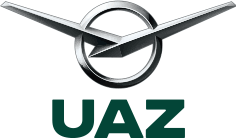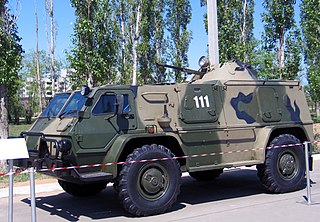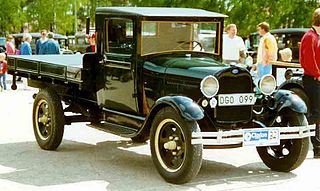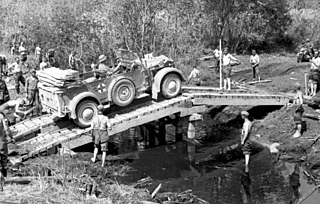
GAZ or Gorkovsky avtomobilny zavod is a Russian automotive manufacturer located in Nizhny Novgorod, formerly known as Gorky (Горький) (1932–1990). It is the core subsidiary of GAZ Group Holding, which is itself part of Basic Element industrial group. JSC Russian Machines is the controlling shareholder in OAO GAZ.

UAZ or Ulyanovsky Avtomobilny Zavod is an automobile manufacturer based in Ulyanovsk, Russia, which manufactures off-road vehicles, buses and trucks. It has been part of the Sollers automotive group since 2000.

Pavlovo Bus Factory is a manufacturer of buses in Russia, in the city of Pavlovo, Nizhny Novgorod Oblast. PAZ is a subsidiary of Russian Buses which is a division of GAZ.

The GAZelle is a series of light commercial vehicle—pickup trucks, vans and minibuses—made by Russian car manufacturer GAZ. At the time of the dissolution of the Soviet Union and transition to a market economy, the Russian automobile industry had not produced a much-demanded LCV similar to the Ford Transit or VW T4 class. The GAZelle shares many parts with the company's passenger cars ; in fact, models produced until 1998 had the same grille. Riga Autobus Factory, which formerly manufactured minibuses for the whole USSR, remained in Latvia, and now required its vehicles be sold to the now-foreign Russian market for hard currency. Responding to this market opportunity, GAZ swiftly developed its own LCV called GAZelle, which, taken together with its lighter version, Sobol, now account for the majority of the Russian van and light truck market and have strong positions in the markets of other CIS countries, ranking as GAZ's most popular and successful products.

Vodnik is a Russian high-mobility multipurpose military vehicle manufactured by GAZ. It is a "heavy modification" of the civil GAZ-2330 "Tigr". Its name comes from the Russian "водник" – a person employed in water transport, but is also used to refer to some person or object simply related to water.

BTR, from Bronetransportyor/Bronetransporter, is any of a series of Soviet or post-Soviet military armoured personnel carriers (APCs).
The automotive industry in the Soviet Union spanned the history of the state from 1929 to 1991. It started with the establishment of large car manufacturing plants and reorganisation of the AMO Factory in Moscow in the late 1920s–early 1930s, during the first five-year plan, and continued until the Soviet Union's dissolution in 1991.

The BA-64 was a Soviet four-wheeled armoured scout car. Built on the chassis of a GAZ-64 or GAZ-67 jeep, it incorporated a hull loosely modeled after that of the Sd.Kfz. 221. The BA-64 was developed between July and November 1941 to replace the BA-20 then in service with armoured car units of the Red Army. Cheap and exceptionally reliable, it would later become the most common Soviet wheeled armoured fighting vehicle to enter service during World War II, with over 9,000 being manufactured before production ended.

Ford Model AA is a truck from Ford. As the Model T and TT became obsolete and needed to be replaced, Henry Ford began initial designs on the Model A and Model AA in 1926. Basic chassis layout was done rapidly and mechanical development was moved forward quickly. Body design and style was developed and then outsourced to various body manufacturers, including Briggs and Murray. The designs of the Model A shared parts and materials with the Model AA Ford, notably the body, engine and interior. The AA usually received plainer interiors than their car counterparts. The Model AA followed similar design changes to the Model A during the AA's four years in production, often delayed anywhere from three to nine months. The mechanical changes and upgrades were done during production of the vehicles. Body changes that occurred between 1929 and 1930 were also integrated into AA production, but leftover parts were used longer in the heavy commercial trucks.

An infantry mobility vehicle (IMV) is a wheeled armored personnel carrier (APC) serving as a military patrol, reconnaissance or security vehicle. Examples include the ATF Dingo, Iveco LMV, Oshkosh M-ATV, AMZ Dzik, AMZ Tur, Mungo ESK, and Bushmaster IMV. This term also applies to Mine-Resistant Ambush Protected (MRAP) vehicles.

The GAZ-46, army designation MAV, is a Soviet-made light four-wheel drive amphibious military vehicle that entered service in the 1950s and has been used by many Eastern Bloc allied forces since.

The Urals Automotive Plant, an Open Stock Company, is a major Russian manufacturer of off-road trucks under the Ural brand. Located in the city of Miass, Chelyabinsk Oblast in the Ural Mountains. The plant was established in 1941; when the ZiS truck plant was evacuated from Moscow during World War II.

GAZ Group is a Russian automotive conglomerate headquartered in Nizhny Novgorod. It comprises 18 manufacturing facilities in eight regions of Russia, as well as sales and service organizations.

The UAZ-452 is a family of four wheel drive off-road vans and light trucks with body-on-frame construction and cab over engine design, built by the Ulyanovsk Automobile Plant (UAZ) since 1965. Originally designed for the Soviet military, since 1985 the vans received updates: more modern engines and internationally compliant lighting, as well as new model numbers, UAZ-3741 for the standard van, while (crew-cab) trucks mostly starting with UAZ-3303, often with one or two extra digits specifying the version. From 1997, bigger UAZ-33036 truck variants with a 25 cm (10 in) longer wheelbase, and taller soft-top roof bows and drop-sides were added.

Einheits-Pkw der Wehrmacht – literally: "standard passenger motor-car of the Wehrmacht" – was Nazi Germany's plan for a new, multi-purpose fleet of all wheel drive off-road vehicles, based on just three uniform chassis, specifically designed and built for the Wehrmacht. The plan was formulated in 1934, and vehicles were built from 1936 to 1943.

The GAZ Sobol is a series of Russian light-duty trucks, vans and minivans, produced by the Gorky Automobile Plant from November 1998. GAZ refers to the Sobol as a minivan.

The Krasnodar mechanical plant of non-standard equipment, commonly known as AvtoKuban, was a Soviet/Russian company that manufactured buses based on truck chassis.

GAZ-3307 and GAZ-3309 are fourth-generation Russian trucks produced by the Gorky Automobile Plant. The GAZ-3307 was announced in late 1989, and the GAZ-3309 was announced at the end of 1994.

The GAZ-3310 Valdai is a medium-class flat bed truck formerly produced from late 2004 until 2015 at the Gorky Automobile Plant in Russia. It differs from the "GAZelle" light commercial vehicle in that it does require a category C driver's license. The production of the truck ended in December 2015.

Belarus had third by volume part of automotive industry of the Soviet Union with near 40,000 annual production. Since that times Belarus specializes on production of own designed superheavy, heavy and middle trucks mainly plus post-Soviet developed buses, trolleybuses and trams. Auto manufacturers in Belarus include MAZ, BelAZ and Neman.


















